
|
 |
part 3 |
Friday May 2019
We take the metro to Chengdu East station. It has a huge departures
hall with thousands of travellers looking for or waiting for their
departing train. 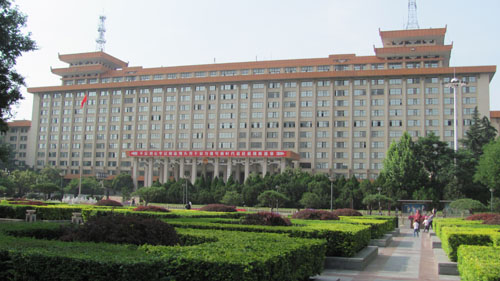 We
are at the station on time. First our ticket is checked and matched with
our passport. Followed by a baggage check. Then we can wait near the
platform entrance. We have another hour. The gates to the platform open
10 minutes before departure and we can go down to the platform. We are
in the last carriage. The journey to Xi’an is going well. Just after 4
o'clock we arrive at Xi'an North Station. We take the metro to the
hotel. The hotel is a 10-minute walk from the Wulukou stop. We stay at
the Mercure, which is located on a former party complex (Renmin Square
or People's Square) with a number of hotels from the Accor family.
Mercure is clearly the poor branch of the family. In any case, it is not
the stately building that you see in front of you when you walk onto the
square. That is the Sofitel Legend Peoples Grand Hotel. The Mercure
building is hard to find and the rooms are a bit worn. Not what we are
used to from Mercure in Europe.
We
are at the station on time. First our ticket is checked and matched with
our passport. Followed by a baggage check. Then we can wait near the
platform entrance. We have another hour. The gates to the platform open
10 minutes before departure and we can go down to the platform. We are
in the last carriage. The journey to Xi’an is going well. Just after 4
o'clock we arrive at Xi'an North Station. We take the metro to the
hotel. The hotel is a 10-minute walk from the Wulukou stop. We stay at
the Mercure, which is located on a former party complex (Renmin Square
or People's Square) with a number of hotels from the Accor family.
Mercure is clearly the poor branch of the family. In any case, it is not
the stately building that you see in front of you when you walk onto the
square. That is the Sofitel Legend Peoples Grand Hotel. The Mercure
building is hard to find and the rooms are a bit worn. Not what we are
used to from Mercure in Europe.
In the afternoon we walk around in the neighborhood. The street is mostly full of stately government buildings and banks. In the evening we eat in the Azur restaurant in the Sofitel. It is a buffet with lots of choice.
Weather: 28 degrees sunny
Sunday 18 May 2019
 After
breakfast we take the Mobike
bicycle to the Central Station. Mobike is a bicycle share system. You
install the mobike app on your mobile phone. That is already possible in
the Netherlands, because Mobike is also active here (Rotterdam, Delft
and The Hague). We have put 10 euros on our account by using a credit
card. That is more than enough, because a trip in China only costs 13
cents. The bike is unlocked by pointing the camera of the phone at the
QR code of the bike from the Mobike app. Very simple. At the
destination, all we have to do is lock the bike to end the ride. You are
no longer allowed to park the bicycles everywhere you want. Parking
areas have been drawn on the sidewalk where the bicycles must be parked.
Other bicycle systems are also active, such as Ô-bike and Hello Bike.
Initially, the share bikes in China led to great chaos and mountains of
bicycle wrecks. Now there are a few suppliers left, who are obliged to
collect the incorrectly parked bicycles and to regroup them at locations
where there is a great demand.
After
breakfast we take the Mobike
bicycle to the Central Station. Mobike is a bicycle share system. You
install the mobike app on your mobile phone. That is already possible in
the Netherlands, because Mobike is also active here (Rotterdam, Delft
and The Hague). We have put 10 euros on our account by using a credit
card. That is more than enough, because a trip in China only costs 13
cents. The bike is unlocked by pointing the camera of the phone at the
QR code of the bike from the Mobike app. Very simple. At the
destination, all we have to do is lock the bike to end the ride. You are
no longer allowed to park the bicycles everywhere you want. Parking
areas have been drawn on the sidewalk where the bicycles must be parked.
Other bicycle systems are also active, such as Ô-bike and Hello Bike.
Initially, the share bikes in China led to great chaos and mountains of
bicycle wrecks. Now there are a few suppliers left, who are obliged to
collect the incorrectly parked bicycles and to regroup them at locations
where there is a great demand.
Tour bus line
no.5 (306) leaves for the Terracotta army at Central
Station. It is a somewhat old bus. The tickets are sold on the bus and
only cost ¥ 7 (€ 0.90). The journey takes approximately one hour. From
the bus stop it's a short walk to the ticket sales office for the
Terracotta museum. Admission costs ¥ 120 (€15,50 / $17,45). It is very
busy.
The terracotta army was first discovered in 1978 by a farmer who wanted to find a well. Excavations brought a gigantic army to light of as many as 8,000 statues of soldiers, officers, chariots and horses. They served as an army in the hereafter for Emperor Qin Shi Huang (259-210 BC), the first emperor, who managed to unite all Chinese kingdoms in 221 BC. It was this emperor who started building the Great Wall. All statues have an individually designed face and pair of hands, which are attached to a standard figure. Everything has been thought of: foot soldiers, cavalrymen, archers, generals, horses, cows etc. etc. The statues are hollow from the thighs up and were originally painted. This discovery of the Terracotta army belies the hitherto common idea that the Qin dynasty was an uncivilized time, in which only brutal violence counted.
We start with hall 3. That is a museum hall, in which a number of 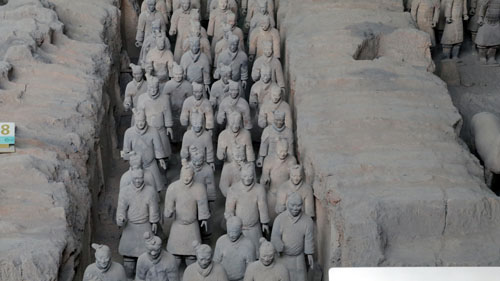 special
sculptures are exhibited, such as chariots with bronze horses. Then we
follow our way to the second hall. There is not much to see here in the
excavation. Digging for statues still goes on here. You look down on an
enormous plain with here and there excavation pits and shards and
pieces. On the side there are four special statues, exhibited in
showcases, of a general, a kneeling archer, a standing archer and a
cavalryman with a horse. Yet it is also very busy here, but nothing
compared to what awaits us in Hall 1. People push and pull in order to
see the famous soldiers who are lined up in front of us. This is also
the place where the statues were first found in 1978 by a farmer who
wanted to find a well. Hall 1 contains 1,000 of the 8,000 statues. We
walk around the entire hall and fight for a place for the best pictures.
special
sculptures are exhibited, such as chariots with bronze horses. Then we
follow our way to the second hall. There is not much to see here in the
excavation. Digging for statues still goes on here. You look down on an
enormous plain with here and there excavation pits and shards and
pieces. On the side there are four special statues, exhibited in
showcases, of a general, a kneeling archer, a standing archer and a
cavalryman with a horse. Yet it is also very busy here, but nothing
compared to what awaits us in Hall 1. People push and pull in order to
see the famous soldiers who are lined up in front of us. This is also
the place where the statues were first found in 1978 by a farmer who
wanted to find a well. Hall 1 contains 1,000 of the 8,000 statues. We
walk around the entire hall and fight for a place for the best pictures.
A bit overwhelmed by the crowds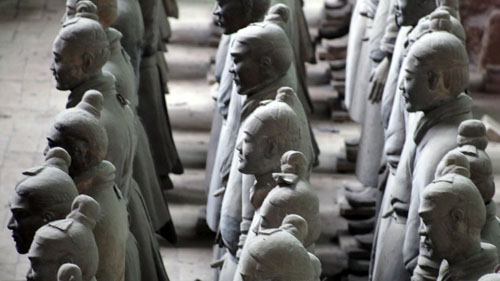 we go outside again, into the bright daylight. Inside it was half dark.
We walk back running the gauntlet of countless food and souvenir stalls
to where we left the bus. The bus arrives after a 5 minute wait.
However, after ten minutes on the way back to Xi'an the bus gives up the
ghost and we have to get out. We can change to the next bus. It is there
almost immediately and we can continue. Back in the city we take the
mobike to the hotel again. We have lunch at the hotel, rest and then
head into the city to the Bell Tower. This originally 16th century tower
(rebuilt in the 18th) was used to indicate the start of the day. A
little further is the drum tower, which marked the end of the day. The
Muslim quarter starts behind the drum tower. About 30,000 descendants of
probably an Arab army that was in the service of th
we go outside again, into the bright daylight. Inside it was half dark.
We walk back running the gauntlet of countless food and souvenir stalls
to where we left the bus. The bus arrives after a 5 minute wait.
However, after ten minutes on the way back to Xi'an the bus gives up the
ghost and we have to get out. We can change to the next bus. It is there
almost immediately and we can continue. Back in the city we take the
mobike to the hotel again. We have lunch at the hotel, rest and then
head into the city to the Bell Tower. This originally 16th century tower
(rebuilt in the 18th) was used to indicate the start of the day. A
little further is the drum tower, which marked the end of the day. The
Muslim quarter starts behind the drum tower. About 30,000 descendants of
probably an Arab army that was in the service of th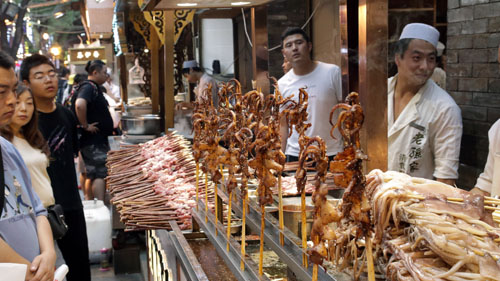 e
emperor, live here. Xi'an was the capital of China during the Tang
dynasty (618-907). Xi'an was also at the end of the silk route and came
into contact with Islam from the Middle East this way. The central
street of the Muslim neighborhood is filled with food stalls and
restaurants and it is a busy place. They sell all kinds of special food
items, many of them grilled on a skewer. Also special are the peanut
cookies, for which men with large wooden hammers beat the batter. The
glass noodles are also famous. You all see how it is made. Most of the
women behind the counters are wearing a headscarf and the men wear small
hats.
e
emperor, live here. Xi'an was the capital of China during the Tang
dynasty (618-907). Xi'an was also at the end of the silk route and came
into contact with Islam from the Middle East this way. The central
street of the Muslim neighborhood is filled with food stalls and
restaurants and it is a busy place. They sell all kinds of special food
items, many of them grilled on a skewer. Also special are the peanut
cookies, for which men with large wooden hammers beat the batter. The
glass noodles are also famous. You all see how it is made. Most of the
women behind the counters are wearing a headscarf and the men wear small
hats.
Weather: 28 degrees and sunny
Sunday 19 May 2019
We take it easy. A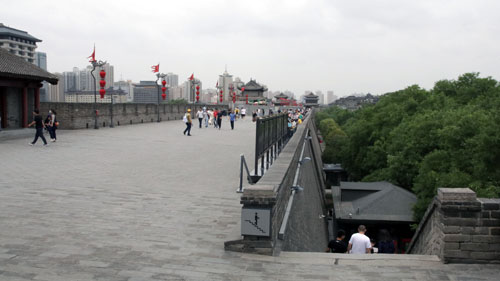 fter
breakfast we have coffee at Starbucks. We go back to the hotel and then
we grab a mobike to cycle to the post office and mail our post cards
home. Then we cycle to the city wall. We go up the wall on the south
side. Admission is ¥ 54 (€ 7). On top we rent bicycles to cycle around
the wall. That costs ¥ 98 (€ 12.60) for two bicycles. We can use them
for three hours. The city wall was originally from the 16th century, but
rebuilt in the 18th century. It has a rectangular shape, with the old
city inside with a grid-shaped street plan. The total perimeter of the
wall is 13 km and there is a large gate on each city side. Later, more
holes were made in the wall for car traffic. The wall is very wide and
there are many people who walk or cycle around the wall. The pavement is
not always smooth, but it not a big deal for the thick tires and the
suspension fork on the bike. On the wall we see many bridal couples
having wedding photos taken. The brides are almost all in red with a
long veil. After the bike ride, we leave the wall to get something to
eat. Oddly enough we find o
fter
breakfast we have coffee at Starbucks. We go back to the hotel and then
we grab a mobike to cycle to the post office and mail our post cards
home. Then we cycle to the city wall. We go up the wall on the south
side. Admission is ¥ 54 (€ 7). On top we rent bicycles to cycle around
the wall. That costs ¥ 98 (€ 12.60) for two bicycles. We can use them
for three hours. The city wall was originally from the 16th century, but
rebuilt in the 18th century. It has a rectangular shape, with the old
city inside with a grid-shaped street plan. The total perimeter of the
wall is 13 km and there is a large gate on each city side. Later, more
holes were made in the wall for car traffic. The wall is very wide and
there are many people who walk or cycle around the wall. The pavement is
not always smooth, but it not a big deal for the thick tires and the
suspension fork on the bike. On the wall we see many bridal couples
having wedding photos taken. The brides are almost all in red with a
long veil. After the bike ride, we leave the wall to get something to
eat. Oddly enough we find o urselves
in a neighbourhood without any eating places. Only old books. We take a
bicycle and eat a little further vegetable dish for ¥ 28 (€ 3.60) for
two people, including a soft drink. Then we cycle back to the hotel. I'm
for a swim in the Sofitel’s pool. It gets a bit noisy when a father
tries to teach his child to swim and constantly dictates the strokes. It
doesn't look very educational.
urselves
in a neighbourhood without any eating places. Only old books. We take a
bicycle and eat a little further vegetable dish for ¥ 28 (€ 3.60) for
two people, including a soft drink. Then we cycle back to the hotel. I'm
for a swim in the Sofitel’s pool. It gets a bit noisy when a father
tries to teach his child to swim and constantly dictates the strokes. It
doesn't look very educational.
In the afternoon we drink a cocktail in the bar of the Sofitel before we
start looking for a recommended restaurant. Unfortunately, it has
disappeared without a trace, while it should have been in operation
since 1898. We then decide to go and eat in a mall, cheaply and not so
bad at all. Back at the hotel, we pack our bags for the next day and
have a drink in the Louis XIII bar of the People’s
Grand hotel, a sister hotel of ours. The building was opened in
1953 as a guesthouse for the government. Now it is one of 5 Sofitel
Legend hotels in the world. It is a different world. It is very chic and
stylish and we enjoy our drink in peace.
Weather: 23 degrees, cloudy
Monday 20 May 2019
We get up at 6.30, have breakfast and then we walk to the Wulukou
metro station. There we take metro line 1 and after one stop line 2 to
the North Station Bei ke Zhan (video).
We arrive well ahead of time for the train to Ping Yao. We have
to wait another hour. The train journey goes well and after more than
two hours we can get off at Ping Yao Old City station, which is oddly
enough 7 km outside the old city of Pingyao. We take a taxi that takes
us up to the city wall of the old city. We have to walk the last bit to
the Yide Hotel.
I t
is not far, but it has become quite warm under the scorching sun. We are
warmly welcomed and we have a choice from two rooms. The lady at the
reception speaks excellent English and is very helpful. It is a
traditional hotel in the old town. The rooms are situated around two
courtyards. The beds are also traditional. It appears to be a rather
hard and thin mattress on a platform, but it turns out to be quite
comfortable. We take a break and then we have lunch at the hotel. The
food is excellent and the staff in the hotel restaurant understand
enough English to help us.
t
is not far, but it has become quite warm under the scorching sun. We are
warmly welcomed and we have a choice from two rooms. The lady at the
reception speaks excellent English and is very helpful. It is a
traditional hotel in the old town. The rooms are situated around two
courtyards. The beds are also traditional. It appears to be a rather
hard and thin mattress on a platform, but it turns out to be quite
comfortable. We take a break and then we have lunch at the hotel. The
food is excellent and the staff in the hotel restaurant understand
enough English to help us.
In the afternoon we walk through the city centre. We drink coffee at a
coffee joint called SeaRocks Coffee, which looked closely at Starbucks
for the design and the product range. We visit a number of museums and
places of interest. For that you have to buy the Pingyao ticket for 120
RMB and then you can into any of the 40 or so museums. We visit the
oldest bank, Rishenchang, where cheques were already being used in 1824.
Before 1912, Pingyao was a banking centre of China. Then, after the
boxer uprising, Hong Kong and Shanghai took over that position. We visit
two more museums. The buildings are a jumble of courtyards and rooms, in
which all kinds of museum pieces are arranged, but after a while they
all look the same.
In the evening we have a delicious dinner in the hotel again and in the
evening, we walk through the streets of Pingyao, which are then
illuminated by red lanterns. It is busy on the street and shop keepers
and restaurant owners shout at the passers-by for business. We end with
a dark beer in a hostel. It is nice and quiet there, except for a
playful kitten.
Weather: 28 degrees, sun
Tuesday 21 May 2019
After breakfast we are picked up by Jonathan, our guide from 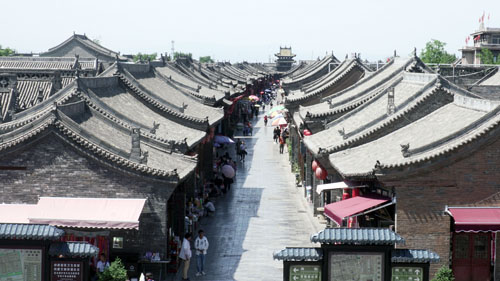 Red
Plum Travel, who is taking us on a bike ride to a temple outside
the city. We first pick up the bikes from a rental place. To get
there we walk for about ten minutes through the old city. We ride on
bicycles, which are fortunately a bit larger than the average Chinese
size, and leave the city centre to take a look at the city wall. The
wall is more than 6 km long and has 6 gates. Then we set course for the
new part of Pingyao towards the temple. The route follows a busy traffic
road along the railroad track. After forty minutes we are at the
Shuanglin temple. Jonathan knows a lot about the meaning of the
different buildings and statues. The complex, largely dates from the
Ming and Qin periods (after 1600) and stands with the entrance to the
South, to the sun. In the buildings there are many Buddha statues in all
stages and positions, also a few Taoist gods are there, just to be sure.
The most important temple buildings have a glazed shaing
Red
Plum Travel, who is taking us on a bike ride to a temple outside
the city. We first pick up the bikes from a rental place. To get
there we walk for about ten minutes through the old city. We ride on
bicycles, which are fortunately a bit larger than the average Chinese
size, and leave the city centre to take a look at the city wall. The
wall is more than 6 km long and has 6 gates. Then we set course for the
new part of Pingyao towards the temple. The route follows a busy traffic
road along the railroad track. After forty minutes we are at the
Shuanglin temple. Jonathan knows a lot about the meaning of the
different buildings and statues. The complex, largely dates from the
Ming and Qin periods (after 1600) and stands with the entrance to the
South, to the sun. In the buildings there are many Buddha statues in all
stages and positions, also a few Taoist gods are there, just to be sure.
The most important temple buildings have a glazed shaing 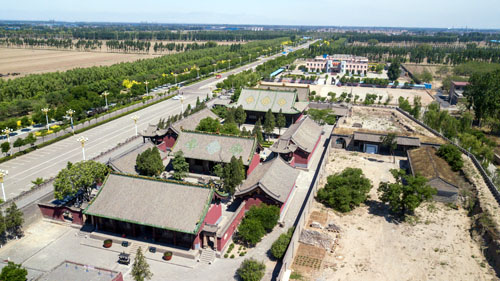 Temple
roof with colorful decorations. The others are less decorated and show a
clay color. At the end of the visit we go up the wall around the temple
and it is time for a flight with the drone.
Temple
roof with colorful decorations. The others are less decorated and show a
clay color. At the end of the visit we go up the wall around the temple
and it is time for a flight with the drone.
The return journey takes a different route, along a very wide road, which runs along neighborhoods that are still under construction and past corn fields, orchards and business parks. Erik gets a flat tire. Jonathan calls the owner who on the electric scooter to help us. He fixes the tyre very quickly, but the delay still takes half an hour. Back in the old city, Jonathan takes us to a bakery where they bake mooncakes according to a traditional recipe with no less than six types of nuts. They taste sweet and delicious.
We then return the bikes and return to the hotel. Meanwhile it has
become incredibly 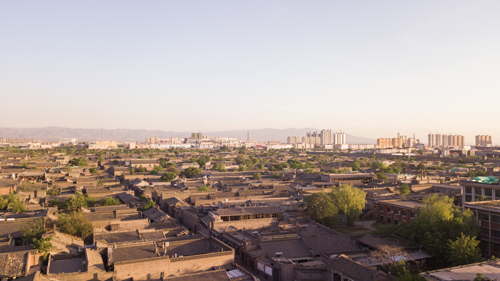 warm
and the sun is high in the sky. We have lunch in the hotel and have a
rest. At three o'clock we go up to the city wall, but it is so hot and
we are still tired from the morning bike ride that we quickly go back to
the hotel. When it gets a little cooler I let the drone up again above
the hotel for some nice pictures of the roofs of the old city. We eat in
the hotel again and after dinner we walk through the old city again.
Withdrawing money from ATM in the old city is not possible, because the
bank behind the machines in the old city does not accept maestro cards.
warm
and the sun is high in the sky. We have lunch in the hotel and have a
rest. At three o'clock we go up to the city wall, but it is so hot and
we are still tired from the morning bike ride that we quickly go back to
the hotel. When it gets a little cooler I let the drone up again above
the hotel for some nice pictures of the roofs of the old city. We eat in
the hotel again and after dinner we walk through the old city again.
Withdrawing money from ATM in the old city is not possible, because the
bank behind the machines in the old city does not accept maestro cards.
In the hotel we have a drink before going to sleep
Weather: 29 degrees and sun
Wednesday 22 May 2019
We We get up early, because our train leaves at 8.40. We already
checked out yesterday and placed our order for breakfast. It all goes so
fast that we are 20 minutes ahead of schedule. We can already leave at
7.20 am with a car arranged by the hotel. The girl from the reception
comes after us, apparently because we have paid twice for breakfast. We
get the money back.
At the station we initially get the normal safety check, but then half
an hour before departure all travellers have to go through the mill
again for Beijing. And now more thoroughly. My Swiss officer's knife has
to stay here. It is taken out of the suitcase and impounded. Then we
have t o
wait in a separate part of the departure hall for a sign that we can go
through the gates to the platform. On the platform we are neatly
aligned at the point where our carriage door is expected to end up. We
get on the train as soon as it arrives and then sit back and relax for 4
hours until we reach Beijing
West. We will arrive at 12.55.
o
wait in a separate part of the departure hall for a sign that we can go
through the gates to the platform. On the platform we are neatly
aligned at the point where our carriage door is expected to end up. We
get on the train as soon as it arrives and then sit back and relax for 4
hours until we reach Beijing
West. We will arrive at 12.55.
In Beijing we take the metro to Dongsi (change trains once) and walk to
the Cote Cour hotel, which is located in a so-called Hutong, an old
working-class area. These Hutongs are located in former family palaces
of the aristocracy, but after the fall of the empire were divided into
small houses. Many of these neighbourhoods have been demolished in
recent decades and replaced by large skyscrapers, but this one has not
(yet). When you walk into the neighbourhood you do not exactly expect to
find a hotel. Narrow streets, small houses, people who are playing
Mahjong on the street… We get there, at least we walk past it, but a
kind police officer walks with us to the hotel entrance we missed. It is
very hot in Beijing and we notice that Chinese men uncover their midriff
to cool down when it is hot.
In the evening we have dinner at Dadong Roast. That turns out to
be a very upmarket place in a super chic shopping mall. Here we order
Peking Duck. The duck is first presented by a cook at the table and then
cut into small pieces. The meat is wonderfully tender and crispy at the
same time. Dadong is one of the 10 best restaurants in the city for
Peking duck and even has an article in the wikipedia.
Weather: 33 degrees and sun in Beijing
Thursday 23 May 2019
We get up early, because today is going to be a hot day. We are having
breakfast 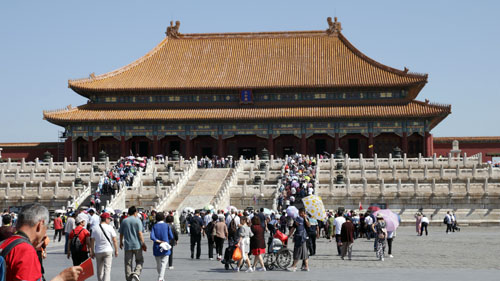 at
7 a.m. and at half past seven we are on our way to the Forbidden City on
Tian’anmen Square. First we buy a Yikatong card. This is an OV
chip card on we store an amount of which we can travel. That is easier
than buying a ticket for every ride. The card costs ¥ 20 (deposit) and
we put ¥ 100 on it. The deposit and the remaining credit can be refunded
upon departure. With the metro we get to Tian'anmen East in 20 minutes.
To be able to enter the square, we must show our passport and go through
a security check. Via a pedestrian tunnel we reach the huge square. The
square measures 440,000 m2 and a million people can gather here. It's
pretty busy on the square, despite the early hour. Groups of tourists
are lined up, photographers offer their services and security personnel
march across the square. Around the square are the Palace of the People
(parliament), the National Chinese Museum, the Mausoleum of Mao (for
which people line up by the hundreds) and the entrance to the Forbidden
City. Exactly 20 years ago, grim scenes played out here when a large student
protest, for more freedom and democracy, supported by the civilian
population, was eventually crushed by the army
at
7 a.m. and at half past seven we are on our way to the Forbidden City on
Tian’anmen Square. First we buy a Yikatong card. This is an OV
chip card on we store an amount of which we can travel. That is easier
than buying a ticket for every ride. The card costs ¥ 20 (deposit) and
we put ¥ 100 on it. The deposit and the remaining credit can be refunded
upon departure. With the metro we get to Tian'anmen East in 20 minutes.
To be able to enter the square, we must show our passport and go through
a security check. Via a pedestrian tunnel we reach the huge square. The
square measures 440,000 m2 and a million people can gather here. It's
pretty busy on the square, despite the early hour. Groups of tourists
are lined up, photographers offer their services and security personnel
march across the square. Around the square are the Palace of the People
(parliament), the National Chinese Museum, the Mausoleum of Mao (for
which people line up by the hundreds) and the entrance to the Forbidden
City. Exactly 20 years ago, grim scenes played out here when a large student
protest, for more freedom and democracy, supported by the civilian
population, was eventually crushed by the army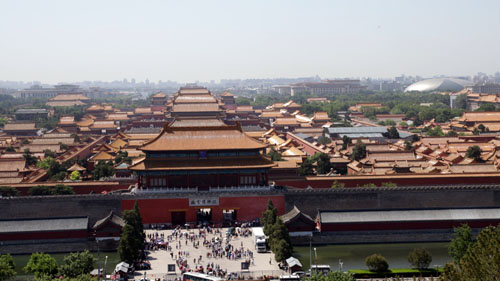 with a lot of bloodshed. Nothing reminds of that anymore. We take some
pictures on the square and then move (through a tunnel under the road)
to Forbidden City. The portrait of Chairman Mao still adorns the
Tian’Anmen gate. Left and right are large stands for party functionaries
during major events. Through the Tiananmen gate we arrive at a large
square. There is a ticket office in a corner. There you have to pay and
your passport is registered. Your passport is then your admission
ticket. Again through a gate and another one and then we come through
the Wumen (Meridian gate), the largest of the gates, that once
could only be used by the emperor. The Forbidden City is a large complex
of 800 palaces and buildings that until 1912 were the exclusive domain
of the imperial family and the royal household. A city in itself that
was forbidden territory for ordinary Chinese. There are 11 Halls and
gates in one straight line between
with a lot of bloodshed. Nothing reminds of that anymore. We take some
pictures on the square and then move (through a tunnel under the road)
to Forbidden City. The portrait of Chairman Mao still adorns the
Tian’Anmen gate. Left and right are large stands for party functionaries
during major events. Through the Tiananmen gate we arrive at a large
square. There is a ticket office in a corner. There you have to pay and
your passport is registered. Your passport is then your admission
ticket. Again through a gate and another one and then we come through
the Wumen (Meridian gate), the largest of the gates, that once
could only be used by the emperor. The Forbidden City is a large complex
of 800 palaces and buildings that until 1912 were the exclusive domain
of the imperial family and the royal household. A city in itself that
was forbidden territory for ordinary Chinese. There are 11 Halls and
gates in one straight line between 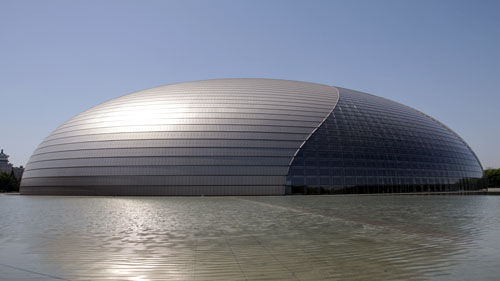 the
Wumen on the South side and North Gate. This forms the backbone of the
complex. We cross the Golden Water Stream (Jinshui He) via bridges and
arrive at another gate, the Taihemen, the gate of supreme
harmony, which is guarded by two large lions. Behind it is another
larger courtyard, where once the imperial audiences were held - as in
the film The Last Emperor by Bertolucci (1987).
the
Wumen on the South side and North Gate. This forms the backbone of the
complex. We cross the Golden Water Stream (Jinshui He) via bridges and
arrive at another gate, the Taihemen, the gate of supreme
harmony, which is guarded by two large lions. Behind it is another
larger courtyard, where once the imperial audiences were held - as in
the film The Last Emperor by Bertolucci (1987).
Elevated on the three-storey high elevation we see the Taihe Dian
(the hall of the supreme harmony). The largest of three main ceremonial
halls. This was used for coronations and birthdays or for appointing
generals for important war campaigns. Behind it is the Zhonghe Dian
(hall of central harmony) with another throne in it, where the emperor
received foreign visitors. Behind it again the Baohe Dian (the
hall for preserving harmony), used for state banquets and imperial
exams.
After this we come to the imperial living quarters. The crowds and the
heat are now beginning to get to us. It is now 34 degrees and the crowds
are immense. We step up the pace a bit and continue to the imperial
gardens. In the center of those gardens is the Qin’an Dian (hall
of imperial peace). Here the emperor came to worship the Taoist goddess
of water, to save the palace from fire. After the gardens we are back on
the street on the north side. We cross the street through a tunnel and
enter the Jingshan Park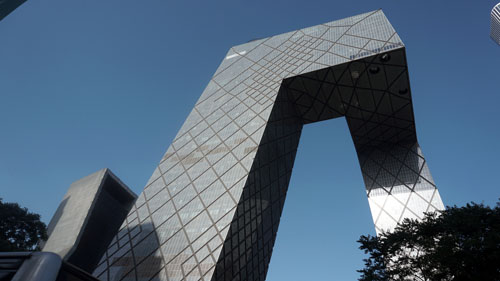 .
Here is an artificial hill, that offers a view over the Forbidden City
and also the entire inner city of Beijing, because there are no other
elevations and no high-rise buildings. The climb up is short, but steep.
Up there I am rewarded with a beautiful view. In the distance I see the
headquarters of the CCTV (by Rotterdam architect Rem Koolhaas) and
closer the shape of the National
Center for the Performing Arts.
.
Here is an artificial hill, that offers a view over the Forbidden City
and also the entire inner city of Beijing, because there are no other
elevations and no high-rise buildings. The climb up is short, but steep.
Up there I am rewarded with a beautiful view. In the distance I see the
headquarters of the CCTV (by Rotterdam architect Rem Koolhaas) and
closer the shape of the National
Center for the Performing Arts.
After I have walked down again we take a taxi to that center. It was
completed in 2007 after a design by the Frenchman Paul Andreu and,
appropriately, called the "egg". The “egg” is lying on its side in the
water and it takes a while to find the entrance. It appears to be sunk
on the north side under the edge of the water. We're going in. After the
safety check we walk into the building through a tunnel under 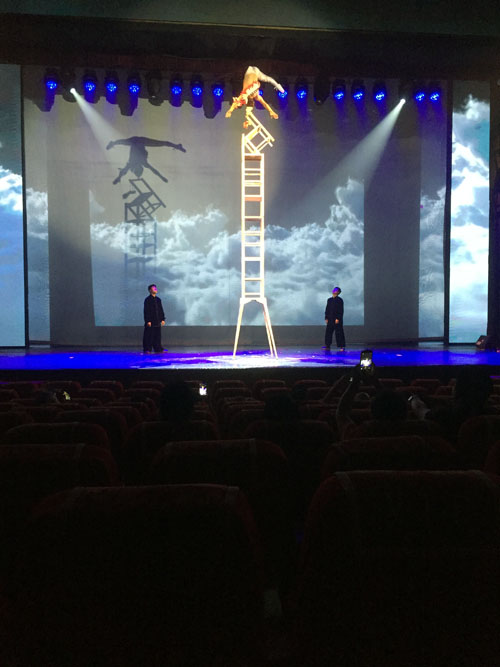 the
water. There are three main halls: an opera, a concert hall and a
theater for plays and ballet. In June the Rotterdam
Philharmonic Orchestra performs here with its chief conductor
Lahav Shani. We see all three rooms and drink coffee in the beautiful
lobby. Then we take the metro back to the hotel.
the
water. There are three main halls: an opera, a concert hall and a
theater for plays and ballet. In June the Rotterdam
Philharmonic Orchestra performs here with its chief conductor
Lahav Shani. We see all three rooms and drink coffee in the beautiful
lobby. Then we take the metro back to the hotel.
Around 5 pm we go to the CCTV
building of Koolhaas
to get a closer look. We are actually too close to it, but it is
impressive. A little further up is the Chaoyang
theater where we are going to see an acrobatic show. I ordered tickets
over the internet months ago via an unofficial website (which does call
itself official, but there appear to be many). The money was debited
from the credit card and I received a 5-digit code via email. That was
all. I had to show it at the box office. I had little faith in it, but
low and behold, I get the tickets for the VIP rows without any problems.
The show is spectacular, with acrobats, jugglers and most spectacular of
all with 9 motorcyclists in a spherical cage. After an hour and a half
we are completely stunned by the show, the music and the video effects.
We have drink on the hotel roof to cool down.
Weather: 37 degrees and sun